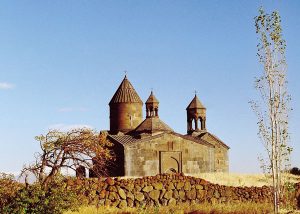Saghmosavank

According to Armenian Church tradition, St. Gregory the Illuminator founded the monastery of Saghmosavank. The monastery that stands on this site today is an 11th-century structure in a spectacular natural setting, at the foot of Mt. Ara, on the edge of a cliff overlooking Kasagh River valley, with Mt. Ararat and Mt. Aragats rising majestically on the western and northern horizons. This monastic complex consists of St. Sion and St. Astvatsatsin Churches, a gavit, and a library. It is said that Saghmosavank was so named because of the monastery’s practice of continuous recitation of Psalms.
St. Sion is the oldest of the structures and was built in 1215 by Lord Vaché Vachutyan, who also built the adjacent gavit later in the 13th century. The 12-paneled, four-pillared dome of the gavit is an exceptional example of Armenian architecture. The gavit along with St. Sion and St. Astvatsatsin churches were used by Lord Kurd Vachutyan as a library in 1255.
Saghmosavank was a famous center of scholarship with an active scriptorium. In 1267, Gevorg Skevratsi copied the Tonapatchar collection and in the same year Vartan Areveltsi opened a school at Saghmosavank. Other notable men of letters who worked at Saghmosavank are Markos and Mkhitar, who copied
the Charentir in 1185-88, Karapet vardapet who copied the Mashtots, and Hovhannes Abegha, who copied the Gospels there in 1496.
Reflection
In our silent prayers let us give thanks to God for protecting this monastery from invasions and natural disasters through the centuries. Let us ask the intercession of the monastery’s founder, St. Gregory the Illuminator (4th cent.) and remember the faith and works of the scholar Gevorg Skevratsi and the benefactor Lord Vaché Vachutyan (13th cent.).
